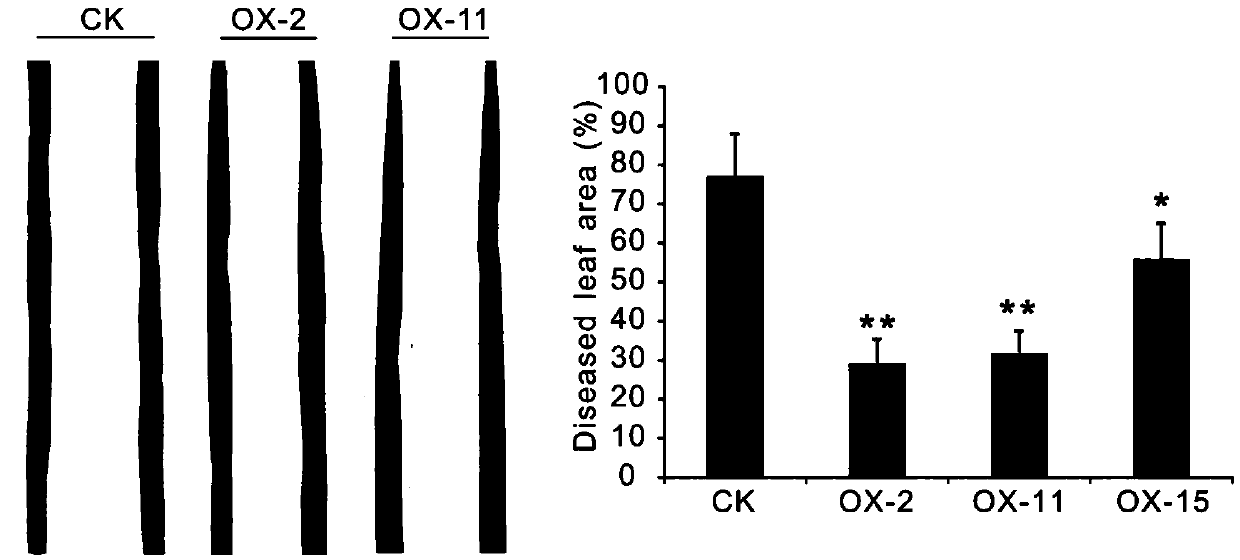Gene Os02g0532500 and protein capable of improving rice blast resistance, and applications of the gene
A rice blast and resistance technology, applied in the field of crop genetics, can solve problems such as difficult and effective implementation, and achieve the effects of ensuring production safety, increasing expression levels, and enhancing rice blast resistance
- Summary
- Abstract
- Description
- Claims
- Application Information
AI Technical Summary
Problems solved by technology
Method used
Image
Examples
Embodiment 1
[0022] Embodiment 1 Improving the gene of rice blast resistance and the construction of overexpression vector
[0023] (1), get the seedling leaf position of Sanhuangzhan No. 2 (SHZ-2) of rice blast high-resistant variety, use TriZolReagent (Invitrogen company, its article number is: 15596026) to extract leaf total RNA, adopt formaldehyde denaturing gel electrophoresis and The purity and quantity of total RNA were detected by ultraviolet spectrophotometer;
[0024] (2) Take 1 μg of total RNA for the initial reverse transcription reaction, the reverse transcriptase used is PrimeScript (TAKARA company), and the steps of the reverse transcription reaction refer to the instructions for use of the reverse transcriptase. Using the reverse transcription product as a template, primers: F, CCGGAATTCAGTGACAGAACGAGCGTAGAAT (SEQ ID No: 3); R, GGAAGATCTTCACTAACGGGGAGTAACCTAA (SEQ ID No: 4), were used for PCR amplification. The polymerase used in PCR was KODFX (Toyobo Company). The reactio...
Embodiment 2
[0027] Example 2 Os02g0532500 Gene Overexpression Effect Identification in Transgenic Plants
[0028] The overexpression vector was transformed into the normal japonica rice variety Nipponbare by the method of genetic transformation mediated by Agrobacterium EHA105. Transformed primary (T 0 Generation) Through PCR and quantitative PCR detection, positive transformed plants were identified from the DNA level and RNA level, proving that the target gene Os02g0532500 has been transformed into rice, and the expression of the target gene Os02g0532500 has been increased.
[0029] In a controlled greenhouse, the transgenic positive plants were selfed to obtain the first generation of homozygous positive transgenes (T 1 Generation) strains, each strain selects 10 plants that are detected as positive by PCR to breed, and obtains T 2 generation plant, T 2 The generation strains were then tested by PCR to find out the strains derived from different T 0 T 2 There were 3 homozygous lines...
Embodiment 3
[0037] Example 3 Identification of rice blast resistance in Os02g0532500 overexpression transgenic plants
[0038] 1. Leaf blast phenotype identification
[0039] 3 homozygous overexpression transgene T in embodiment 2 2 Seeds of generation strains (OX-2, OX-11, OX-15) and wild type rice were germinated at 32°C, and after 2 days, the young shoots were transferred to plastic trays filled with soil for sowing. Sow 30 seeds separately, one plastic tray contains 3 transgenic lines and wild-type lines, and 3 biological replicates. When the seedlings grew to the 3-leaf stage under natural conditions, the seedlings were transplanted into an artificial climate box for inoculation.
[0040] The artificial climate box was set as follows: temperature, 25°C; light, 16000 LUX; 12h day and night; humidity, 100%. The rice blast strain used was Nipponbare-sensitive GD08-T13. strains (at a concentration of 1x10 6 spores / ml) was sprayed on the leaves, cultivated in total darkness for the f...
PUM
 Login to View More
Login to View More Abstract
Description
Claims
Application Information
 Login to View More
Login to View More - R&D
- Intellectual Property
- Life Sciences
- Materials
- Tech Scout
- Unparalleled Data Quality
- Higher Quality Content
- 60% Fewer Hallucinations
Browse by: Latest US Patents, China's latest patents, Technical Efficacy Thesaurus, Application Domain, Technology Topic, Popular Technical Reports.
© 2025 PatSnap. All rights reserved.Legal|Privacy policy|Modern Slavery Act Transparency Statement|Sitemap|About US| Contact US: help@patsnap.com



